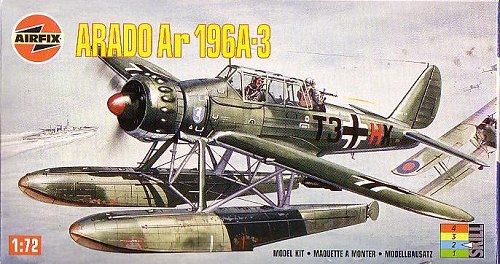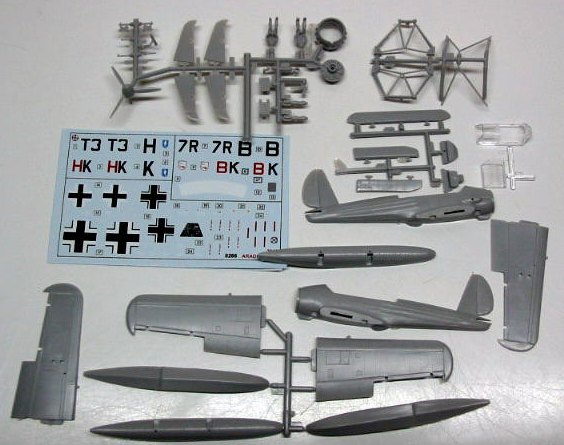
|
KIT: |
Airfix 1/72 Ar-196A-3 |
|
KIT # |
2019 |
|
PRICE: |
$7.00 |
|
DECALS: |
Two options |
|
REVIEWER: |
Bill Michaels |
|
NOTES: |
Good decals, detailing. Cockpit and canopy weak points. |

|
HISTORY |
The Ar-196 was one of the most successful floatplanes used by Germany in WW2. It was the standard shipboard catapult floatplane, carried aboard Battleships and Cruisers. In addition to Naval use, the plane was also used for coastal reconnaissance and patrol duties. As the war progressed, the plane was also used for anti-submarine patrols, and was sometimes used to attack RAF Coastal Command Whitleys.
The plane was well armed for a floatplane. It had two wing-mounted 20mm cannon and a 7.92mm machine gun in the fuselage. For rear defense, the plane carried twin 7.92 mm machine guns on a flexible mount for the rear gunner. The plane could also carry two 50 Kg (110 lb) bombs under the wings.
The Ar 196A-3 debuted in 1940, replacing the A-1 model. The A-3 (and later, the nearly identical A-5) featured better radio equipment and greatly increased armament over the A-1. From 1940 through 1944, almost 500 A-3 and A-5 aircraft were produced. Arado was the primary manufacturer, but additional aircraft were built in occupied France by S.N.C.A and in the Netherlands by Fokker.
|
THE KIT |

This is a preview of the current release of a kit that has been around for a long time. (It dates back to at least the early 1970s.) As such, the kit comes in the bigger Series 2 Airfix box that opens on the ends. This kit is not listed on Airfix’s website as a current kit, but it should be easy to find from a number of dealers and shops. I picked mine up for less than $2 in one of Model Expo’s super Airfix clearance sales.
The kit is dated in design, from the days when moveable parts were a desirable feature. As a result, the model has moveable ailerons and elevators. The moveable control surfaces are really a drawback. I built a copy of this kit with my son a few years ago. The moveable parts result in gaps that are much larger than scale, and the fit was such that the parts don’t move all that well—the ailerons move too much, and the elevator hardly moves at all.
The kit consists of 42 parts, molded in light grey plastic. Overall, considering the age of the kit, the parts don’t look bad at all. There was very little flash in the moldings, for example. Surface detail is fairly restrained, as well—the model is not covered with huge rivets. Most of the model’s surface has raised panel line detail, and not too bad at that. The relatively small number of rivets are actually pretty small in size, and rather subdued-looking. Also, the fuselage has a very subdued fabric effect for the area aft of the cockpit.
The cockpit is typical for Airfix kits of the era. Detail consists of two instrument panels, a control yoke, two seats, and a crude gun and mount. A pilot and gunner figure are provided—they appear to be the standard Airfix generic WW2 pilot and rear gunner figures. Typical of the era, there is no sidewall detail on the inside of the fuselage.
The fuselage consists of left and right halves, with the rudder molded in. The front end consists of three pieces- cowl, prop, and separately molded radial engine. The canopy is molded in two pieces, with the pilot’s canopy one part, and the rest of the canopy the other. The pilot’s canopy can’t be posed open though, because the parts are too thick.
The instructions are the typical modern Airfix/Humbrol form. The first page consists of a short history of the type in five languages. Assembly steps are pictorial, with colors called out by Humbrol number only.
While the kit is the same old moldings from way back, this release of the kit does have some improvements over the old ones. The decals and the painting instructions are much nicer than the ones that came in the old version of the kit. The instructions include a separate full-size sheet of paper with nice left, right, top and bottom views showing colors and decal placement. The sheet is printed front and back, covering the two markings options, one per side. My one complaint is that the colors are only given as Humbrol numbers, with no color names.
As mentioned the decal sheet is very nice. The decals are printed well, with colors properly registered, and they look to be fairly thin. The kit includes markings for two aircraft:
(1) An aircraft from 2./Bordfl. Gr.196, Seeluftskreitkrafte, North Sea Area, 1940. This aircraft is in a two tone splinter scheme on top, with light blue undersides.
(2) An aircraft from 2./SAGr. 125, Luftwaffe, Suda Bay, Crete, 1943. This aircraft is in green topsides, with light blue undersides with white wingtips.
|
CONCLUSIONS |
Conditionally recommended. This is a good kit for beginners. This is a simple model, and is easy to assemble. My 8 year old son built this one with very little assistance from Dad. The float struts are designed to be sturdy, and are easy to install. I was pleasantly surprised, too, by detail on the wings and fuselage—I expected big panel lines and rivets.
The other choice for an Ar 196A-3 in this scale is the Heller/Encore kit. While I haven’t seen either of them in person, I understand that they are more detailed than the Airfix version, and therefore may be a better choice for more experienced modelers. (But, you’re unlikely to find either of them on sale for under three dollars!) Revell also has an Ar 196A-2 model currently available. (I’ve never seen inside the box, but the little photo on the side looks nice.)
Review kit courtesy of my wallet.
If you would like your product reviewed fairly and quickly by a site that has nearly 250,000 visitors a month, please contact me or see other details in the Note to Contributors.